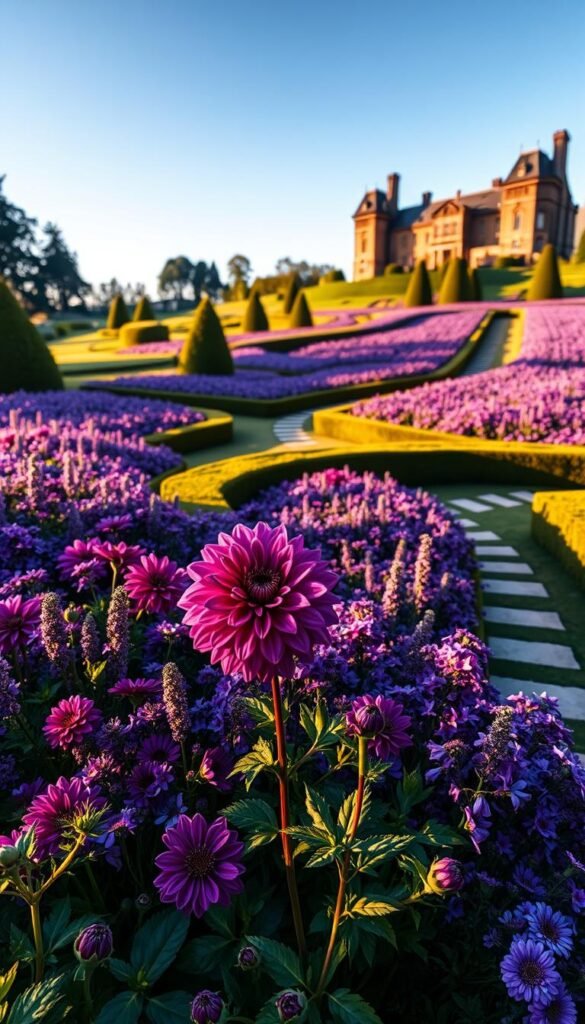Imagine stepping into your backyard and feeling like royalty. Certain color choices hold unmatched power to elevate ordinary spaces into jaw-dropping retreats. Rich, velvety tones have long symbolized luxury – think crowns draped in amethyst silk or palaces adorned with violet tapestries.
You can harness this timeless elegance through strategic plant selection. Soft lilac varieties create peaceful corners perfect for morning coffee, while bold plum petals add striking contrast to green foliage. These hues naturally complement yellows, whites, and even fiery oranges without clashing.
Seasoned designers often use this chromatic magic to build visual depth. A well-planned layout ensures something blooms from spring frosts to autumn’s first chill. You’ll maintain interest as early crocuses give way to summer irises and fall asters.
The best part? This approach works whether you’re updating patio containers or redesigning acreage. Even small touches – like potted heliotrope near seating areas – make spaces feel intentionally curated rather than randomly planted.
Transforming Your Outdoor Space with Regal Purple Accents
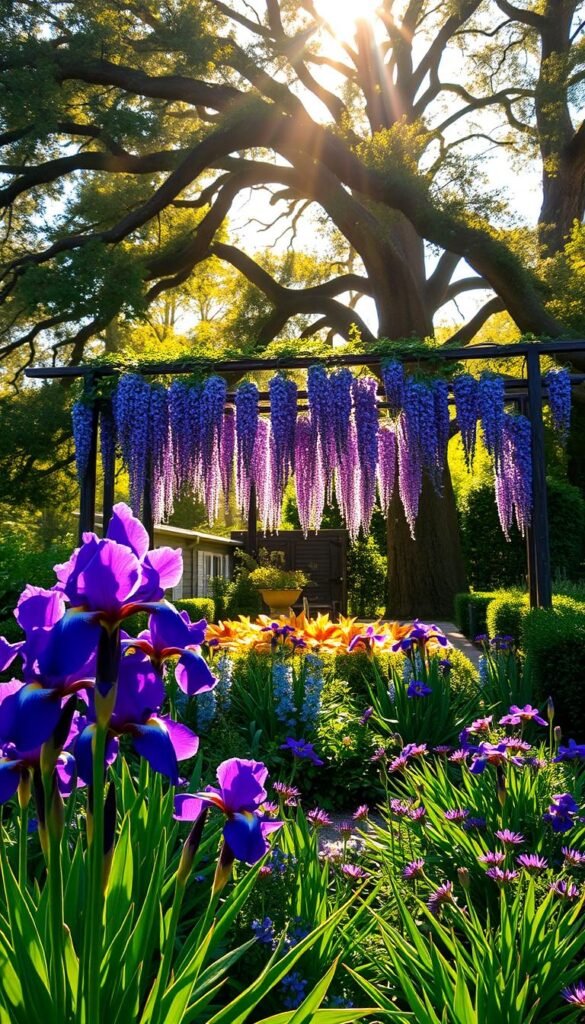
Your outdoor space holds untapped potential to become a regal retreat. Start by sketching ideas that balance bold color statements with natural surroundings. Whether working with raised beds or balcony containers, strategic placement creates focal points that command attention.
Setting Your Garden Vision
Map your area using simple tools like sun calculators or shadow-tracking apps. Consider these elements:
- Light intensity: Full-sun varieties thrive with 6+ hours of direct light
- Existing features: Use stone paths or fences as backdrops for climbing vines
- Growth patterns: Pair spreading groundcovers with upright bloomers for layered effects
Identifying Your Space and Sunlight Exposure
Track how shadows move across your yard during peak growing months. Many vibrant species flourish in morning light but need afternoon protection. For shaded corners, try woodland phlox or lobelia hybrids that brighten dim areas.
Create microclimates by positioning taller shrubs west of delicate specimens. This simple trick shields tender petals from harsh rays while maintaining air circulation. Remember: healthy roots matter more than instant density – give each specimen room to mature.
Designing a Dramatic Landscape with Purple Flowers
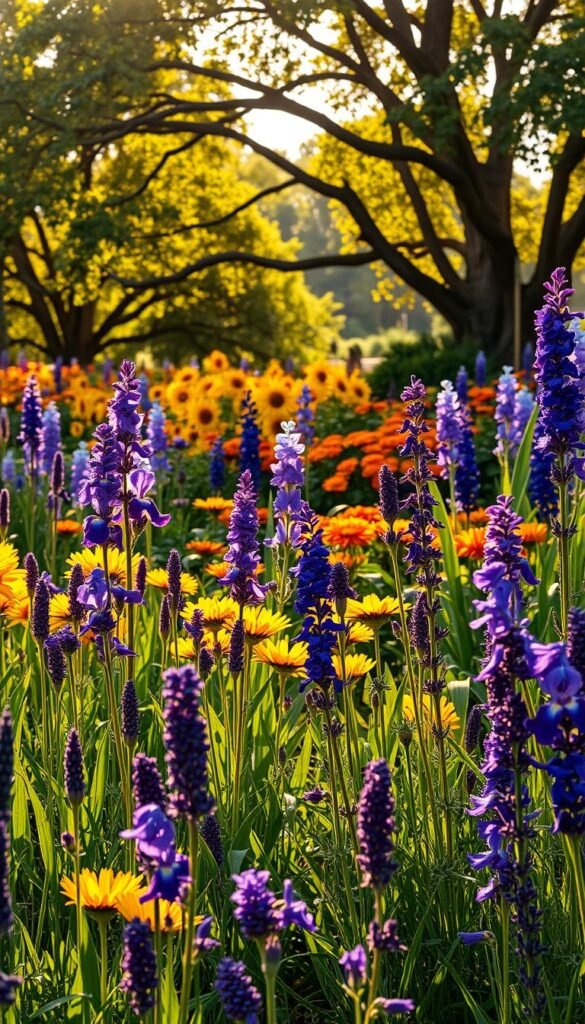
Transform your outdoor area into a living masterpiece by understanding how chromatic relationships work. Strategic pairings can amplify visual impact while maintaining balance—like conducting an orchestra where every hue plays its part.
Leveraging Color Theory for Impact
Cool-toned companions like silvery sage or azure delphiniums soften intense plum tones, creating refreshing summer retreats. These combinations work because they sit side-by-side on the color wheel, enhancing each other naturally. Want more energy? Introduce golden marigolds or tangerine daylilies for sparks of warmth.
Monochromatic schemes showcase texture variations. Pair velvety petunias with spiky lavender spikes for depth. This approach keeps the eye moving without overwhelming the senses. Remember: contrast isn’t just about opposites—it’s about intentional balance.
Seasoned designers often follow the 60-30-10 rule. Let dominant shades cover 60% of your landscape, secondary tones 30%, and accents 10%. This formula prevents chaos while letting bold specimens shine. Test combinations using paint swatches before planting to avoid clashes.
Your space becomes cohesive when repeating key colors across different zones. A cluster of violet alliums near a silver-leafed shrub ties distant beds together. With these techniques, you’ll craft professional-level designs that feel both unified and dynamic.
Choosing the Right Purple Flower Varieties
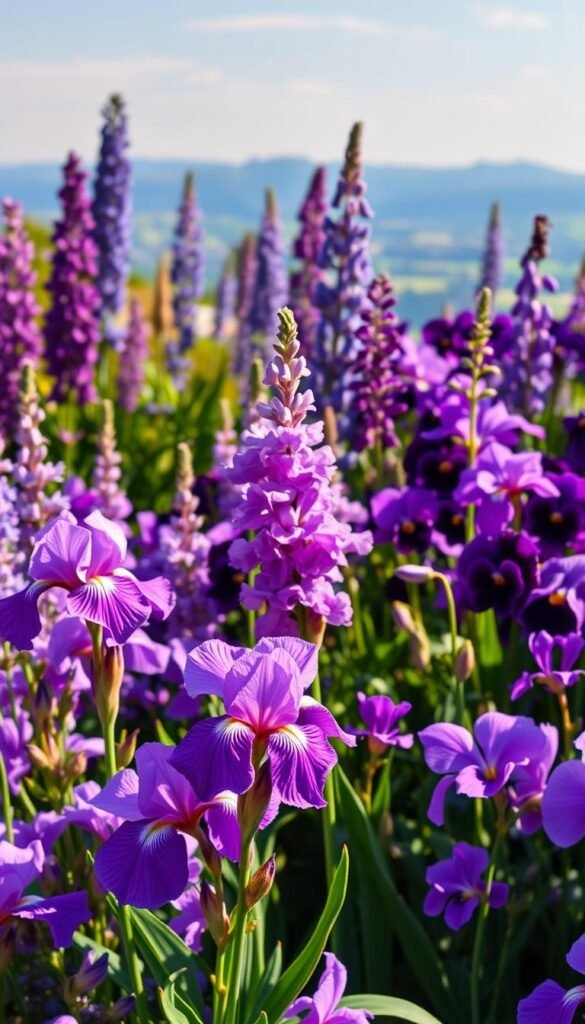
Selecting plants that thrive in your climate and design vision makes all the difference. Let’s explore how to balance long-term performers with seasonal showstoppers while adding sensory appeal.
Perennials, Annuals, and Vines
Long-lasting favorites like lavender and salvia offer reliability, returning stronger each year. These hardy perennials form your garden’s backbone. For instant impact, annual petunias deliver months of vibrant color but need yearly replanting.
Vertical spaces become living art with climbing clematis or sweet peas. Train them over arches or fences to maximize small areas. Pair these vines with low-maintenance flowers for raised beds to create layered displays.
| Type | Examples | Bloom Period | Care Tip |
|---|---|---|---|
| Perennial | Iris sibirica | Spring-Early Summer | Divide every 3 years |
| Annual | Petunia ‘Wave Purple’ | Summer-Frost | Deadhead weekly |
| Vine | Clematis ‘Jackmanii’ | Summer | Prune Group 3 |
Unique Blooms and Fragrances
Spherical allium flowers add architectural interest, while trumpet-shaped blooms create focal points. For fragrance, plant heliotrope near seating areas—its vanilla-like scent intensifies at dusk.
Mix early bloomers like crocus with late-season asters for nonstop color. Compact border plants work well beside towering specimens, creating depth. Always check sunlight needs—salvia loves full sun, while some iris types tolerate shade.
Purple Flower Garden: Royal Hues for a Dramatic, Elegant Landscape
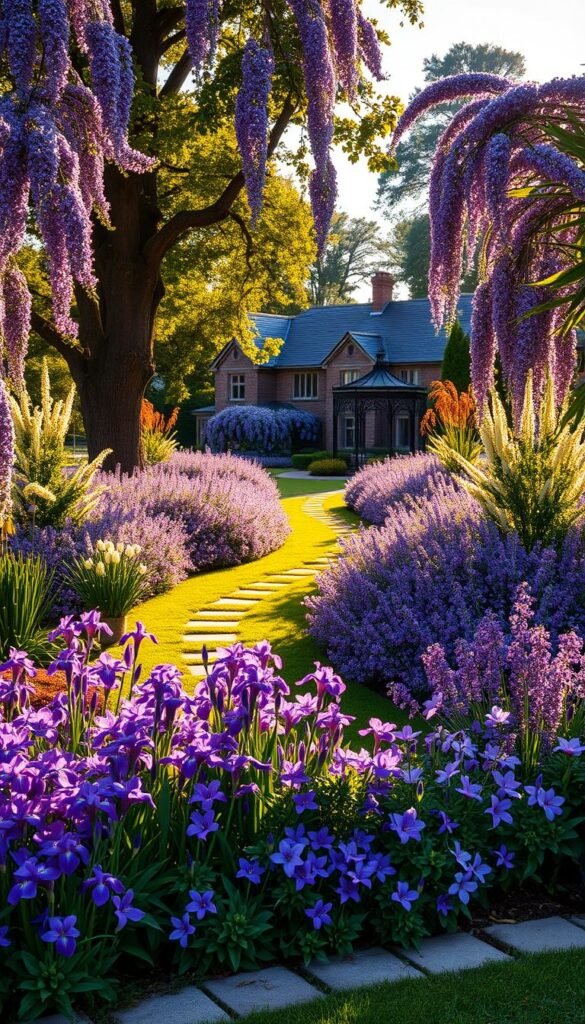
Create a captivating outdoor oasis with blooms that span from delicate pastels to deep, rich tones. These chromatic wonders transform ordinary spaces into immersive escapes, where every petal tells a story of sophistication.
Start by exploring nature’s full palette. Pair misty lilac asters with bold grape hyacinths for striking contrast. Lighter tones soften pathways, while intense violet clusters anchor focal points. This layered approach builds depth without visual overload.
Smart sequencing ensures continuous color. Early crocuses emerge as winter fades, followed by summer’s fragrant lilies and autumn’s spiky sage blooms. Mix textures too—velvety pansies beside feathery cosmos leaves keep eyes dancing across your design.
Balance is key. Offset jewel-toned specimens with silver foliage or cream-colored companions. For cohesive elegance, repeat your two favorite hues in different areas. Need inspiration? Discover creative approaches in this guide to chromatic garden design.
Your space becomes a living canvas where friends gather under twilight’s glow. Children chase butterflies between bloom towers, and morning coffee tastes richer surrounded by nature’s regal charm. With thoughtful placement, even small yards feel expansive and intentional.
Creating Colorful Combinations and Contrasts
Unlock new dimensions in your outdoor space through strategic color partnerships. Thoughtful pairings elevate your design from pleasant to extraordinary, guiding the eye while establishing mood. Master these techniques to make every bloom count.
Complementary Colors and Accents
Yellow companions make violet tones pop like fireworks at dusk. Try golden coreopsis behind plum-toned salvias for instant drama. Chartreuse foliage adds sizzle – imagine lime-colored heuchera leaves framing deep wine petunias.
“Contrast creates energy, while harmony brings peace. The magic happens when you balance both.”
White and silver act as visual breathers between bold shades. Plant snow-in-summer along pathways to separate fiery combinations. This trick prevents color overload while highlighting your star specimens.
| Color Combo | Effect | Plant Examples | Bloom Period |
|---|---|---|---|
| Yellow + Violet | Vibrant energy | Black-eyed Susan + Russian Sage | Summer-Fall |
| White + Deep Plum | Classic elegance | Shasta Daisy + ‘Black Knight’ Delphinium | Late Spring |
| Chartreuse + Wine | Modern edge | Golden Japanese Forest Grass + ‘Black Pearl’ Iris | Spring-Summer |
Pairing with Neutrals for Balance
Cream and gray tones soften intense hues without competing. Try dusty miller beside midnight-blue lupines for sophisticated contrast. These neutrals work like picture frames, directing attention to your chosen color showstoppers.
Mix textures within similar shades for subtle depth. Pair velvety pansies with spiky veronica stalks in matching violet tones. Add silver-leafed artemisia for reflective surfaces that amplify nearby colors.
Remember to repeat key combinations throughout your garden. A cluster of white alyssum near the patio echoes distant planting beds, creating visual threads that tie spaces together. This approach builds cohesion while allowing variety in each area.
Tips for Planting in Full Sun and Partial Shade
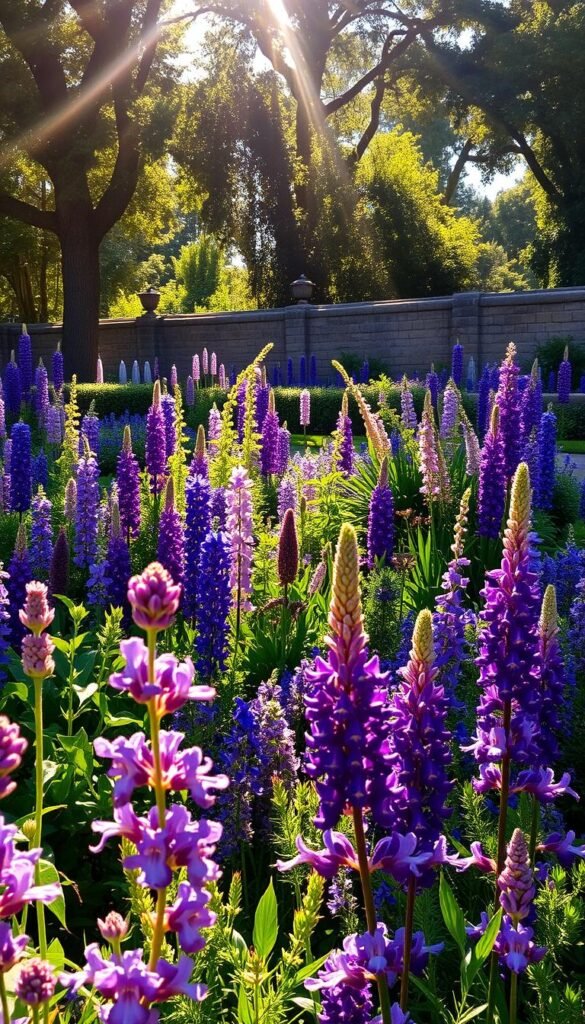
Sunlight acts as nature’s choreographer, directing how your plants grow and bloom. Matching specimens to their ideal light conditions ensures vibrant displays while reducing maintenance. Let’s explore how to work with your space’s natural rhythms.
Understanding Sunlight Requirements
Full sun means six or more hours of direct light daily – perfect for lavender and coneflower. Partial shade areas get three to six hours, often with afternoon protection. Track shadows using a sun calculator app to identify microclimates.
Morning light suits shade-preferring varieties like torenia, while afternoon shelter prevents scorching. Clematis vines thrive where roots stay cool but stems reach sunlight. Observe patterns through seasons – a spot that’s shaded in spring might bake in summer.
Optimizing Plant Placement
Group sun-loving salvia in southwest zones where light lingers. Use taller plants as living umbrellas for delicate specimens. Prune overhanging branches to transform shaded spots into full sun partial zones for iris varieties.
| Light Condition | Plant Examples | Placement Tip |
|---|---|---|
| Full Sun | Russian Sage, Coneflower | South-facing slopes |
| Partial Shade | Torenia, Clematis | East of deciduous trees |
| Transitional Zones | Iris, Phlox | Between buildings & open areas |
Create gradual transitions between bright and shaded areas. This lets you mix light-tolerant species while maintaining visual flow. Remember: proper placement reduces watering needs and boosts bloom production.
Seasonal Care for Your Purple Garden
Keep your outdoor space thriving year-round with smart seasonal strategies. Each period brings unique tasks that ensure healthy growth and continuous color. Let’s explore how timing affects your plants’ performance.
Spring and Summer Planting Strategies
Early spring wakes dormant roots. Plant perennials like salvia as soil warms, giving them time to establish before summer heat. Annuals thrive when added after frost risks pass—try petunias for instant impact.
Late summer offers a second planting window. Divide overgrown clumps to refresh beds. Water deeply during dry spells, but avoid wetting leaves to prevent mildew.
Fall and Winter Maintenance Tips
Fall’s cooler temps make ideal conditions for bulb planting. Tuck tulips and alliums into soil 6 weeks before hard frosts. Mulch beds after first freeze to protect roots.
Winter demands less work but watchful eyes. Clear debris where pests hide. Wrap delicate shrubs in burlap if extreme cold threatens. Your preparation now ensures spring’s triumphant return.

